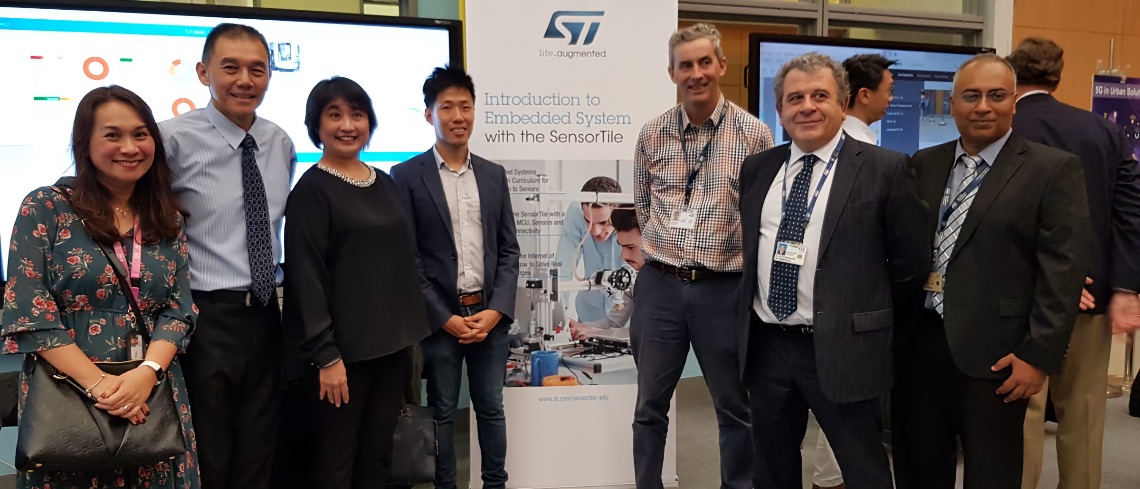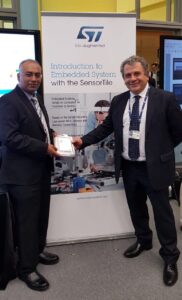Last January, ST joined Nanyang Polytechnic (NYP) Institute in Singapore as they opened the Application & Experience Center for 5G (APEX5G) in partnership with StarHub, one of the four major telecommunication companies in the country. It was a great privilege to take part in this event and a testament to the long and fruitful collaboration between ST and NYP. We host about five interns from the school and provide SensorTile (STEVAL-STLKT01V1) kits that were showcased during APEX5G’s opening. We also have training partnerships in place and signed a memorandum of understanding with the establishment in September 2019, further solidifying our relations. Let’s thus look at how our support to NYP and their contributions to our operations led to a demo that used the SensorTile demonstrating how sensors could take advantage of upcoming 5G networks.
Nanyang Polytechnic and ST to Collaborate to Develop Hardware and Software Solutions
The School of Engineering of Nanyang Polytechnic used the SensorTile in a predictive maintenance setting. The platform is popular among universities as more adopt the SensorTile Curriculum. The students in Singapore relied on the ST sensors to monitor the operations of a Georg Fischer 5-Axis CNC Machining Centre. The microcontroller on the SensorTile collected the information from the various sensors and sent it to a gateway using the built-in Bluetooth module. The gateway then relayed it to a 5G modem, which transmitted that information to a cloud platform that would use machine learning algorithms to predict failures or maintenance operations.
The industry now expects predictive maintenance to bolster real-world applications. It was thus exciting to see NYP students showcase to the world a practical machine learning application using existing components. The demonstration was a direct result of the memorandum of understanding that focuses on the Industrial Internet of Things and, more precisely, equipment monitoring, among many other things.
Nanyang Polytechnic and ST also worked on the software. The fact that we host interns means that they have access to many of our engineers and experts, which helps them deepen their technical and application understanding and optimize their applications. For instance, the school started working on this project using a TCP protocol to transmit data, which makes sense given its ubiquity. They then moved onto UDP to ensure they could collect and send data from multiple sensors at the same time before settling on MQTT. The students are also working on one of our STM32MP1 Discovery Kit (STM32MP157C-DK2) to turn it into the gateway. They are using the BluePy Python library to more efficiently handle the transmission of the data through the Bluetooth interface. The software is thus particularly interesting because it showed the accessibility of our platform.
ST With Nanyang Polytechnic to Innovate in Our Factories
ST is also thrilled with this collaboration because Nanyang Polytechnic has an excellent reputation, and it is a privilege to host brilliant students that continue to have such a positive influence on our operations. For instance, the NYP interns helped us look at technical challenges differently. Our teams noticed their work and realized we could draw from it to use SensorTile boards in our factories to measure the humidity levels to optimize our nitrogen management. Traditionally, a piece of similar equipment costs thousands of dollars. After looking at the code from the NYP students, our developers adapted it to an industrial setting and were able to use SensorTile boards connected to the ST network, the total of which only comes up to hundreds of dollars. Beyond the obvious financial benefits, it also allowed us to improve our operations and reduce our environmental impact.
It is a special partnership when both sides can learn from each other. The memorandum of understanding includes training opportunities from NYP covering IoT, digital manufacturing, and Industry 4.0. We are also looking forward to working together on new issues and offer the students additional opportunities while continually challenging the way we think about our operations and innovations.

